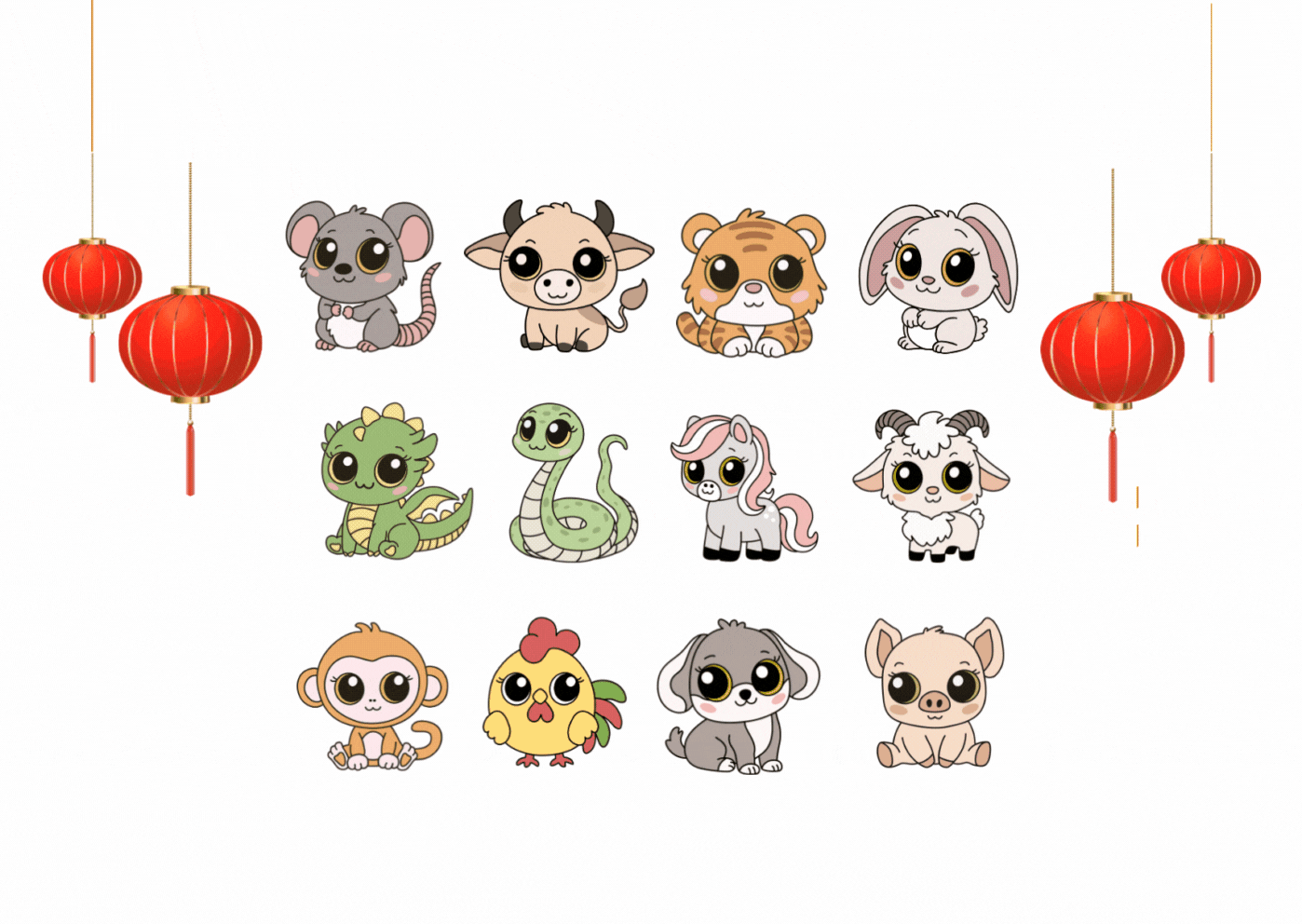" The Jade Emperor's Great Test: Chinese Zodiac Animals, Elements, and Their Cyclical Interaction."
The story of the Jade Emperor's Great Test is a vibrant and engaging Folk Tale that explains the order of the Animals in the Chinese zodiac. It's a Fable, passed down through generations to make the zodiac's order more memorable and meaningful.
CELEBRATIONS
1/29/20255 min read


The Jade Emperor's Great Test: Zodiac Animals, Elements, and Their Cyclical Interaction
The story of the Jade Emperor's Great Test is a vibrant and engaging folk tale that explains the order of the animals in the Chinese zodiac. It's a myth, passed down through generations to make the zodiac's order more memorable and meaningful. Countless variations exist, but the core elements remain consistent. This story also intertwines with the influence of the Five Elements (Wood, Fire, Earth, Metal, Water) which further shape the characteristics associated with each animal and year.
The Jade Emperor, the supreme ruler of Heaven in Taoist mythology, devised a great test to determine the order of animals in his heavenly calendar. The first twelve creatures to successfully complete the test would be honored with a year in the 12-year cycle. The test involved various challenges, emphasizing the unique abilities and traits of each animal.
The Rat (鼠 - Shǔ): Clever and cunning, the Rat, lacking physical strength, cleverly befriended the powerful Ox. It rode on the Ox's back, then, just before reaching the end of the test, jumped off and scurried ahead, securing first place. This highlights the Rat's intelligence and resourcefulness.
The Ox (牛 - Niú): Strong and hardworking, the Ox was a natural contender. However, its straightforward nature and trust in others led it to be tricked by the Rat, placing it in second. This shows the Ox's strength and dedication, even if naive at times.
The Tiger (虎 - Hǔ): Brave and powerful, the Tiger demonstrated its inherent boldness and strength by fearlessly completing the test, securing third place.
The Rabbit (兔 - Tù): Agile and quick-witted, the Rabbit demonstrated exceptional agility and resourcefulness to navigate the challenges, showcasing its speed and cleverness.
The Dragon (龍 - Lóng): Majestic and powerful, the Dragon, though capable of easily completing the test, paused to help others, showcasing its benevolent nature and earning it fifth place. Some versions state the Dragon used its powers to overcome obstacles to help the one’s in need on the way.
The Snake (蛇 - Shé): Graceful and sly, the Snake skillfully navigated the test, demonstrating its adaptability and strategic thinking.
The Horse (馬 - Mǎ): Swift and spirited, the Horse completed the test with impressive speed, securing a strong middle position through its inherent speed and vigor.
The Goat (羊 - Yáng) / Sheep: Gentle and calm, the Goat carefully and methodically completed the test, representing its peaceful and considered nature and its resilience.
The Monkey (猴 - Hóu): Playful and clever, the Monkey used its agility and intelligence to creatively solve the test’s challenges, highlighting its quick thinking and resourcefulness.
The Rooster (雞 - Jī): Brave and persistent, the Rooster bravely overcame obstacles, demonstrating courage and determination to reach the end of the test.
The Dog (狗 - Gǒu): Loyal and hardworking, the Dog completed the test with perseverance and faithfulness, earning its place through sheer determination and loyalty.
The Pig (豬 - Zhū): Relaxed and enjoying the process, the Pig completed the test at its own pace, representing the Pig's easygoing and contented nature.
"The Five Elements and Their Influence"
The Five Elements (Wu Xing) – Wood, Fire, Earth, Metal, and Water – are fundamental to Chinese philosophy and influence the characteristics of each animal sign and the yearly energies. These elements cycle and interact, creating dynamic combinations that add layers of interpretation to the zodiac. Each animal is associated with a specific element, further enriching their characteristics. The element associated with the year also interacts with the animal's element, impacting the overall energy of that year.
Needless to say, the Chinese zodiac is a very complex system, weaving together the twelve animals with the five elements in a dynamic, cyclical interaction. Each animal is associated with a specific element, and this element changes over a 60-year cycle. This means that not only does the animal change yearly, but the elemental influence on that animal also rotates, creating a much more nuanced and intricate system of prediction and personality interpretation. The dynamic interplay of the five elements creates a rich tapestry of meaning within the Chinese zodiac. Their cyclical interactions are essential for understanding both the yearly energies and the nuanced personalities associated with each animal sign, highlighting the system's enduring depth and relevance.
"Wood (木 - Mù)"
Characteristics: Growth, flexibility, creativity, kindness, gentleness, generosity, compassion, springtime, upward movement, expansion. Wood represents the potential for growth, development, and the beginning stages of life.
Associations: Trees, plants, forests, springtime, the liver and gallbladder (in traditional Chinese medicine).
Positive Traits: Compassionate, nurturing, flexible, adaptable, innovative.
Negative Traits: Stubborn, inflexible, overly sensitive, rigid.
"Fire (火 - Huǒ)"
Characteristics: Passion, energy, enthusiasm, leadership, transformation, summer, warmth, brightness, upward movement. Fire represents transformation, power, and the peak of energy.
Associations: Sun, flame, heat, summer, the heart and small intestine (in traditional Chinese medicine).
Positive Traits: Passionate, enthusiastic, inspiring, confident, dynamic.
Negative Traits: Impulsive, aggressive, arrogant, reckless.
"Earth (土 - Tǔ)"
Characteristics: Stability, practicality, nurturing, reliability, groundedness, late summer, central position, absorption, consolidation. Earth represents stability, balance, and the grounded aspects of life.
Associations: Soil, mountains, valleys, late summer, the stomach and spleen (in traditional Chinese medicine).
Positive Traits: Stable, reliable, nurturing, practical, supportive.
Negative Traits: Stubborn, rigid, possessive, inflexible.
"Metal (金 - Jīn)"
Characteristics: Precision, strength, decisiveness, order, structure, autumn, coolness, sharpness, downward movement, contraction. Metal represents structure, order, and the harvest.
Associations: Metals, minerals, rocks, autumn, the lungs and large intestine (in traditional Chinese medicine).
Positive Traits: Decisive, organized, strong-willed, analytical, precise.
Negative Traits: Rigid, controlling, critical, inflexible, materialistic.
"Water (水 - Shuǐ)"
Characteristics: Adaptability, intuition, wisdom, emotional depth, winter, fluidity, mystery, downward movement. Water represents fluidity, adaptability, and wisdom born from experience.
Associations: Water bodies (rivers, oceans), winter, the kidneys and bladder (in traditional Chinese medicine).
Positive Traits: Wise, intuitive, adaptable, compassionate, understanding.
Negative Traits: Passive, emotionally unstable, manipulative, secretive.
The five elements are interconnected and influence each other in a cyclical pattern, creating a dynamic balance. Understanding this interaction is crucial for interpreting the complexities of the Chinese zodiac and its application in various aspects of Chinese culture.
"The 60-Year Cycle"
The 60-year cycle is created by combining the 12-year animal cycle with the 5-element cycle. This results in a unique combination of animal and element for each year. This combination further modifies the characteristics of the animal for that specific year. For example, a Wood Rat year will feel different from a Fire Rat year, even though the core characteristics of the Rat remain.
"Understanding the Elemental Rotation"
The elemental association for each animal follows a specific pattern within the 60-year cycle. While the exact order can be complex to chart out completely, understanding the general pattern is key. The pattern isn't simply a linear progression (e.g., Wood, Fire, Earth, Metal, Water, then repeating). The order varies slightly depending on the source and the specific cyclical model being used. However, the underlying principle remains consistent: each animal will cycle through all five elements over a 60-year period.
"Impact on Yearly Energies and Individual Personalities"
The cyclical nature of the elements within each animal's 60-year rotation significantly impacts:
* Yearly Energies: The combination of the animal and its element for a given year creates a unique energetic landscape. For instance, a Fire Horse year might be more energetic and passionate than a Wood Horse year, which might be more creative and flexible. An Earth Pig year might be more grounded and stable than a Water Pig year, which might be more intuitive and adaptable.
* Individual Personalities: An individual's personality is further nuanced by the element associated with their birth year's animal. A person born in a Metal Dog year might display a stronger sense of order and decisiveness than someone born in an Earth Dog year, who might be more grounded and practical.
The complex interplay of the animals and elements within the 60-year cycle gives the Chinese zodiac its depth and richness. It's this intricate combination that provides a more comprehensive understanding of yearly energies and individual personalities than one might think !!


